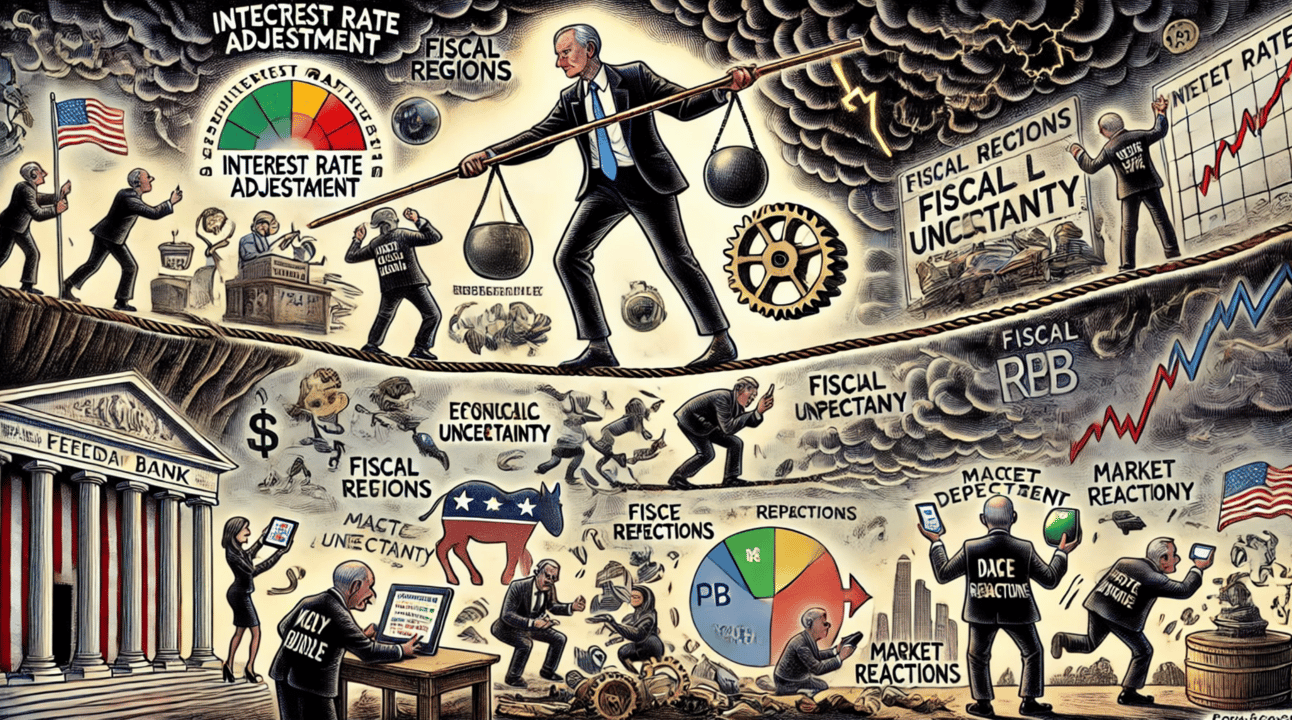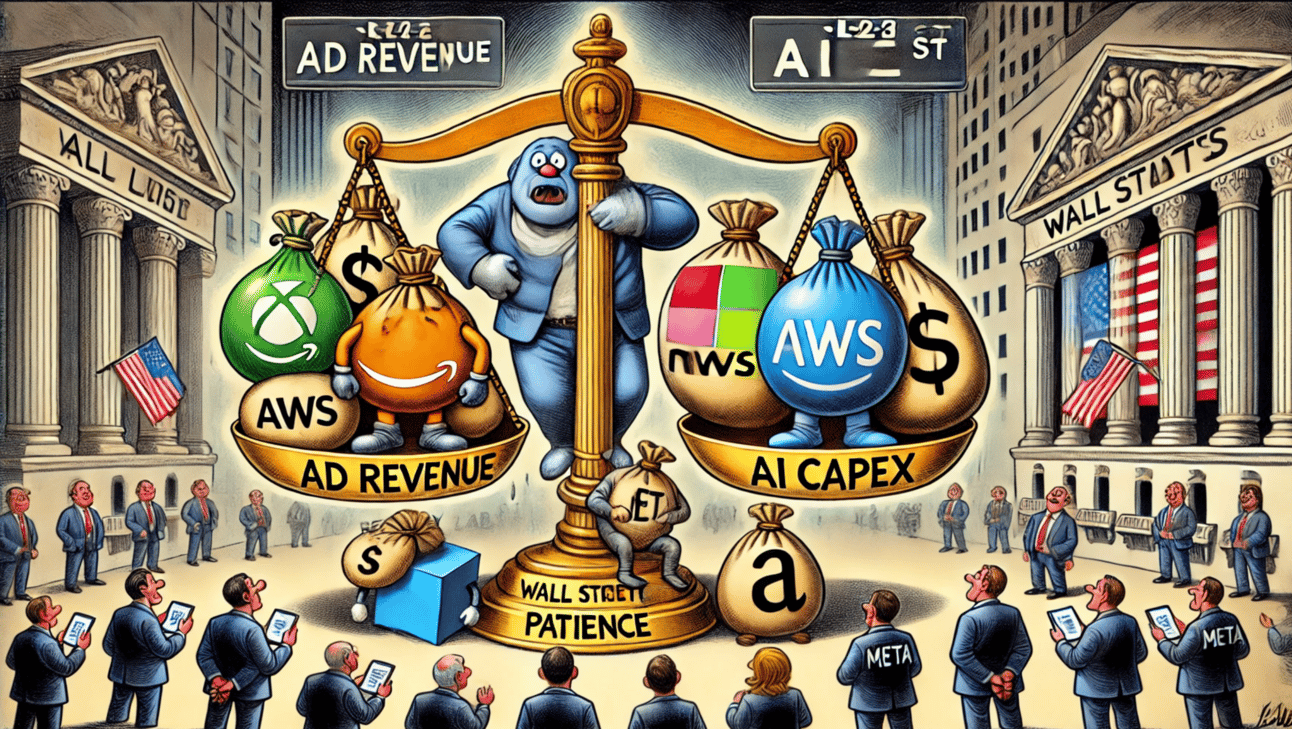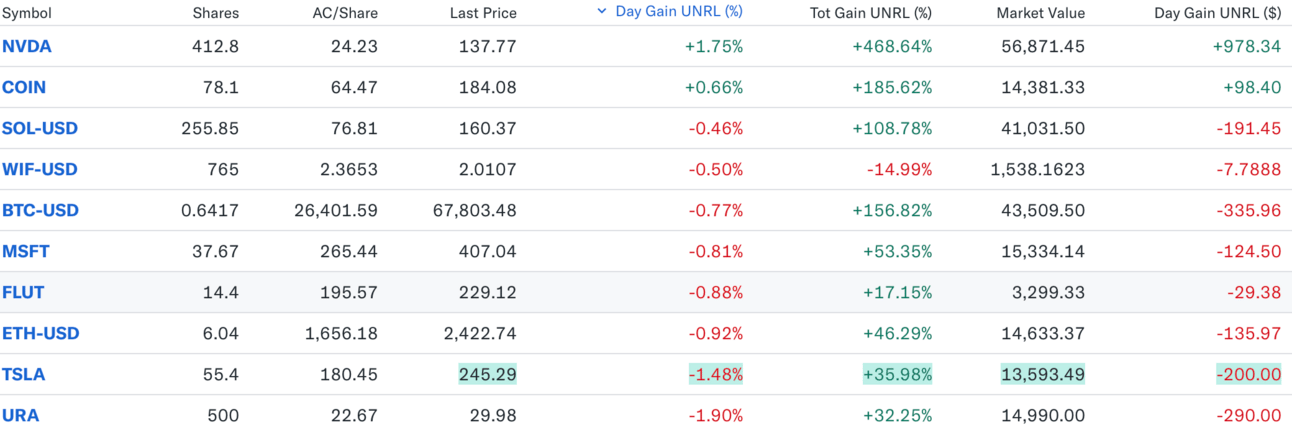- The BRRR
- Posts
- Big Tech Earnings, Election & Fed Countdown
Big Tech Earnings, Election & Fed Countdown
PLUS: We bought a new crypto asset 👀
TheBRRR’s Thoughts
Editor’s note: the podcast is back! We generate a full conversation between two AIs covering the day’s most interesting stories. Subscribe on Spotify and Apple to get notifications when a new episode drops.
As we enter one of the most pivotal weeks of the year, we’re watching Big Tech earnings alongside an election that could shake markets—and the Fed’s next rate decision. For Big Tech, Q3 results were a mixed bag. Alphabet and Amazon demonstrated that AI spending can yield immediate returns in advertising and cloud, sending their stocks higher. But not everyone is seeing results as quickly: Microsoft and Meta faced backlash from investors weary of high capex and slower payback periods. Apple, meanwhile, has held back on AI spending, prioritizing steadier returns, a strategy that could start to look appealing as capex-heavy tech giants scramble for profitability.
All of this plays out against the backdrop of tomorrow’s U.S. election and the Fed’s anticipated 25 bps rate cut on Thursday. Polling momentum seems to be shifting towards Harris, pulling back Trump-related trades and sending the dollar down sharply while Treasuries gain. Election uncertainty will likely stretch beyond Tuesday, especially with swing states like Pennsylvania and Georgia potentially facing delayed results. A prolonged contest could inject volatility across asset classes, as markets brace for fiscal policy shifts.
So how do you navigate this high-stakes week? Here’s what we’re covering:
Big Tech Earnings: Why Amazon and Alphabet are winning the AI spending game, and how other tech giants are struggling to keep Wall Street’s confidence.
Election-Driven Market Moves: A Harris polling lead has reversed the “Trumpflation” trades—weakening the dollar and strengthening Treasuries—while the election outcome remains uncertain.
The Fed’s Dovish Pivot: Expected to cut rates by 25 bps, the Fed’s move could signal a softer monetary policy stance, which may benefit tech and other growth sectors sensitive to borrowing costs.
Election & Fed Cut To Drive This Week’s Action

Synopsis:
This week’s focus is on the U.S. election and the Federal Reserve’s anticipated 25 bps rate cut, both of which are expected to drive significant market movements. With uncertainty surrounding key swing states and potential delays in final vote counts, volatility is likely across asset classes. Meanwhile, the Fed’s cut on Thursday could be overshadowed by election-driven fiscal uncertainty, which may complicate future monetary policy direction.
The Details:
Election Impact: Markets are reacting to fluctuating predictions around a Republican sweep. Prediction markets show Trump’s probability bouncing between 48% and 61% across different platforms. Key swing states (MI, AZ, WI, NV) may report quickly, but outcomes in PA and GA could take days or weeks, especially if contested.
Market Reaction: Bond yields saw notable movement, with the 10-year yield rising 14.4 bps last week. As of today, Treasuries are up sharply, reversing Friday’s losses, while the dollar is down nearly half a percent.
Federal Reserve’s Expected Rate Cut: A 25 bps cut on Thursday seems likely, but Powell’s statement could be intentionally vague due to election-related fiscal uncertainty. The Fed may signal a data-dependent stance for future meetings, keeping rate cut projections flexible, especially if economic growth metrics surprise in either direction.
International Developments: China’s National People’s Congress could announce stimulus measures by week’s end, and the Bank of England is expected to cut rates by 25 bps, bringing rates to 4.75%.
Other Economic Data: The U.S. will release September factory orders and the ISM services index this week. Initial jobless claims, the University of Michigan sentiment survey, and several Treasury auctions are also scheduled.
WHY IT MATTERS:
For traders, this week is pivotal. A contested or delayed election result could prolong fiscal uncertainty, possibly affecting Treasury yields and currency markets. A rate cut from the Fed could signal a dovish pivot amid economic softness, influencing sectors like tech and real estate that benefit from lower rates. Global events, particularly China’s stimulus potential, could sway commodity markets, especially energy and metals, providing trading opportunities.
Bullet Points:
Election Uncertainty: Trump’s win probability fluctuates (currently 58%), creating volatility in bonds and the dollar.
10-year Treasury Yield: Rose 14.4 bps last week; Treasuries rally as election nears.
Fed Cut Expected: 25 bps rate cut likely on Thursday; data dependency likely emphasized.
China Stimulus Potential: New fiscal measures anticipated, could influence global markets.
BoE Rate Cut: Expected 25 bps cut to 4.75% as U.K. grapples with slowing economy.
Big Tech’s Earnings Are In: Here’s The Report Card

Big Tech’s Earnings: The Battle Between AI Spending and Investor Patience
Synopsis: Big Tech’s Q3 earnings showcased strong performances across the board, but Wall Street’s reception was far from uniform. Alphabet and Amazon won over investors with immediate returns from AI spending, driving stock gains, while Microsoft and Meta faced scrutiny for high capital expenditures without sufficient near-term profitability.
Meanwhile, Apple stood out by largely sidestepping the AI arms race, staying steady with minimal capex. The earnings season underscored that the market favors tech giants demonstrating tangible returns, highlighting both the pressure and opportunities AI spending brings.
The Details:
Alphabet (GOOGL):
Revenue & Cloud Growth: Alphabet reported revenue of $86.3 billion, up 13% year-over-year, driven by robust advertising revenues from Google Search ($48 billion) and YouTube ($9.2 billion). Google Cloud surged 35%, showing a 9.4% profit margin—a pleasant surprise for investors who had questioned the sustainability of Alphabet’s AI-heavy spending.
Stock Performance: Alphabet shares rose by 6%, as strong ad and cloud revenue proved AI investments were beginning to pay off.
Amazon (AMZN):
Revenue: Amazon achieved a 14% increase in revenue to $169.9 billion, with AWS up 13% at $24.2 billion and advertising rising by a notable 26.7% to $14.7 billion.
AI Strategy and Stock Gains: AWS benefited from infrastructure investments in generative AI, including tools like the Bedrock AI platform and Rufus shopping assistant. This immediate return on AI investments drove an 8% jump in Amazon’s stock.
Microsoft (MSFT):
Cloud and Capacity Constraints: Microsoft reported $62 billion in revenue, an 18% YoY increase. Azure grew 33%, fueled by AI demand, though capacity constraints limited growth, prompting Microsoft to scale up capex to $43 billion.
Stock Drop: Despite growth, Microsoft’s stock declined by 6% as investors questioned its long-term capex trajectory. A weaker-than-expected revenue outlook for next quarter and a $1.5 billion projected hit from an AI investment in OpenAI compounded market jitters.
Meta Platforms (META):
Revenue and AI in Advertising: Meta’s $40.1 billion revenue marked a 25% rise, while net income surged 300%, partly due to cost-cutting and enhanced AI-driven ad targeting. Meta’s focus on AI-led engagement boosts across Facebook, Instagram, and WhatsApp continues to be well-received by users.
Investor Sentiment: Meta’s AI payoffs in ad efficiency were well-received, but the extended timeline for Reality Labs’ profitability tempered enthusiasm, with shares seeing only a slight increase.
Apple (AAPL):
Revenue & Minimal AI Spending: Apple’s revenue hit $119.6 billion, up 2% YoY. The iPhone accounted for 60% of sales, rising 6% to reach $69.7 billion. By largely bypassing the AI spending spree, Apple reported steadier financials without sacrificing capex or balance sheet flexibility.
Stock Reaction: Apple’s cautious approach kept its stock stable, though there’s concern over stagnation in non-iPhone segments like iPads and wearables.
Why It Matters:
For traders and investors, Big Tech’s earnings spell out a clear divergence in AI investment strategies. Alphabet and Amazon, with their immediate AI-driven revenue boosts, demonstrate how capex can reward patient shareholders. In contrast, Microsoft and Meta, despite strong growth, face mounting pressure to balance ambitious capex with visible returns. Apple’s conservative approach also highlights a viable path, preserving flexibility by not fully joining the AI race. These dynamics underscore that AI spending alone isn’t enough; proving a path to profitability is essential to maintain Wall Street’s favor.
Key Takeaways:
Alphabet and Amazon Lead on AI Returns: Their demonstrated gains in cloud and ads reward patient investors, with Alphabet up 6% and Amazon by 8% following earnings.
Microsoft and Meta Hit by AI Skepticism: Despite growth, prolonged paybacks have made Wall Street cautious, with Microsoft down 6% amid capacity constraints and high capex.
Apple’s Steady Strategy: Avoiding the AI race has preserved Apple’s balance sheet, but questions remain about stagnation in non-iPhone segments.
Long-Term AI Implications: Nvidia remains positioned to benefit from Big Tech’s AI infrastructure demands, though growth could moderate as current AI buildouts near completion.
The Big Picture for Investors:
This earnings season reinforces the emerging trend: AI-related spending must demonstrate near-term profitability to justify high capex. As the AI investment narrative shifts from “building” to “returning,” Big Tech faces heightened expectations to make good on these vast expenditures. The focus now lies on companies that can capitalize quickly—providing immediate returns while managing future profitability. The cautious or capital-efficient players, like Amazon and Alphabet, seem best positioned to navigate both the AI-driven growth and Wall Street’s demands for disciplined spending.
Decentraland 2.0 is now live
Decentraland is a virtual social world where you can meet new friends, join events, and make memories—no matter where you are. Whether exploring the open, community-built landscape, partying on the dancefloor, or watching a binary sunset on the beach, Decentraland is where people from everywhere come together.
Premium Subscriber Section

You’ll need to upgrade your subscription to view our portfolio and get our real-time trade alerts. You can upgrade for $3/month or $14.99/year.
Trades, Watchlist & Live Portfolio
(paywall only)
Most Recently Revealed Trade:
Wednesday April 17 2024: We bought more Solana at $131 and added Solana’s top memecoin WIF at $2.36 on the heels of a leverage wipeout dip after the WW3 scare.

Here’s the link to The BRRR Technical Analysis Chatbot - let me know what you think!
Portfolio Notes
Monday November 4 2024: We haven’t updated the portfolio below, but we’re buying AI memecoin GOAT at its current $520m valuation as the fastest horse in a broad crypto rally post-election.
June 12: These assets all look great for continuation higher.
We are considering moving on from Tesla as it has lagged the rest of our portfolio badly and doesn’t have an obvious catalyst. We’ll monitor and let you know if we decide to move on.

Older Notes
Wednesday, April 3, 2024: We haven’t deployed the cash yet, but are eyeing exposure to a few assets including META and PLTR.
Monday, March 11, 2024: We sold Apple this morning. The newsletter held the stock from inception a year ago for a meager 12% gain.
The company has lost its magic evident by complacent iPhone releases, lack of a coherent vision for AI integration and punitive & anti-competitive App Store policies.
We believe the stock will move in-line with the broader Nasdaq going forward.
We’ll sit on the cash for now, but plan to redeploy it quickly.
Watchlist
$META: Sleeper in AI race and ad biz is proving resilient
How was today's email? |
Got feedback? Follow the writer on Twitter @frank_locascio and send a message.
The BRRR is meant for informational purposes only. It is not investment advice. Please consult with your investment, tax, or legal advisor before making any investment decisions.ll
Reply